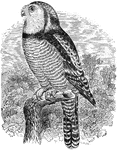
Hawk Owl
"Surnia funerea. American Hawk Owl. Day Owl. Bill and eyes yellow; claws brownish-black. Upper parts…
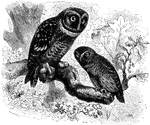
Saw-whet and Sparrow Owls
"Nyctala - Saw-whet Owls. Skull and ear-parts highly unsymmetrical, the the latter of great size, and…
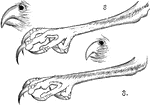
The Beaks and Claws of a Burrowing Owl
"Speotyto. Burrowing Owls. tarsi long, about twice as long as the middle toe without its claw, very…
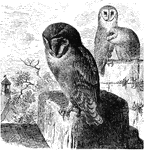
Barn Owls
"Aluco flammeus pratincola. Barn Owl. above, including upper surfaces of wings and tail, tawny, fulvous,…

Burrowing Owl
"Speotyto cunicularia hypogae'a. Burrowing Owl. Adult: Above, dull grayish-brown, profusely spotted…

Marsh Hawk
"Circus cyaneus hudsonius. American Marsh Hawk, Harrier. Blue hawk. Adult Male: In perfect plumage pale…

Harrier Ear Parts
"Circinae. Harriers. Face surrounded with an incomplete ruff (as in most owls); orifice of ear about…
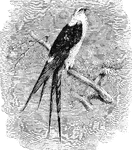
Swallow-tailed Kite
"Elanoides forficatus. Swallow-tailed Kite. Adult: Head, neck, band on rump, and entire under parts,…
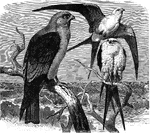
Two Swallow-tail and One Mississippi Kites
Two Swallow-tail and One Mississippi Kite. "Ictinia subcaerulea. Mississippi Kite. General plumage plumbeous…
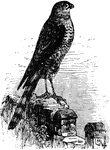
Sharp-shinned Hawk - Small
"Accipiter fuscus. Sharp-shinned Hawk. "Pigeon" Hawk. Above, dark plumbeous, slate-color, or bluish-gray,…
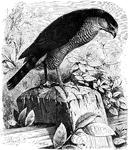
Sharp-shinned Hawk
"Accipiter fuscus. Sharp-shinned Hawk. "Pigeon" Hawk. Above, dark plumbeous, slate-color, or bluish-gray,…

Axial Skeleton
"Ideal plan of the double-ringed body of a vertebrate. N, neural canal; H, haemal canal; the body separating…

The Axial Skeleton
"Fig 55. - Actual section of the body in the thoracic region of a bird. N, neural canal; H, haemal canal;…
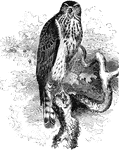
American Goshawk
"Astur atricapillus. American Goshawk. Blue Hen Hawk (adult). Chicken Hawk (young). Adult: Above, dark…
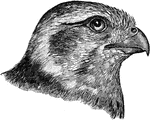
Prairie Falcon Head
"Falco mexicanus. American Lanner Falcon. Prairie Flacon. A medium-sized species, distinguished from…
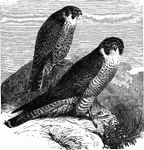
Two Lanner Falcon
"Falco mexicanus. American Lanner Falcon. Prairie Flacon. A medium-sized species, distinguished from…

Falcons
"Falcons. Bill furnished with a sharp tooth and notch near the end of the cutting edge of the upper…

Peregrine Falcon Small
"Falco peregrinus. Peregrine Falcon. Duck Hawk. Great-footed Hawk. A medium-sized falcon, about as large…
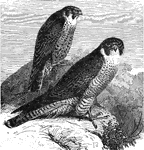
Two Peregrine Falcons
"Falco peregrinus. Peregrine Falcon. Duck Hawk. Great-footed Hawk. A medium-sized falcon, about as large…
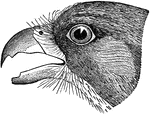
Sparrow Hawk
"Falco sparverius. Rusty-crowned Falcon. Sparrow Hawk. Adults: Crown ashy-blue, with a chestnut patch,…

Caracaras
"Polyborus auduboni. Common Caracara. General color blackish, the throat, neck all around, and more…

Red-tailed Buzzard
"Buteo borealis. Red-tailed Buzzard. "Hen Hawk". Upper surface of tail rich chestnut, with white tip…

American Rough-legged Buzzard
"Archibuteo lagopus sancti-johannis. American Rough-legged Buzzard. "Black Hawk" Adult: Too variable…

Bald Eagle
"Haliaetus leucocephalus. White-headed Sea Eagle. "Bald Eagle." "Bird of Washington". Adult: Dark brown;…
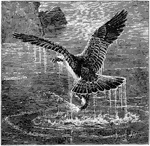
Osprey
An Osprey catching a fish. "Pandion haliaetus. Fish Hawk. Osprey. Adult. dark vandyke- brown, blackening…
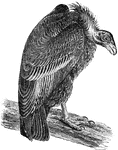
California Condor
"Pseudogryphus californianus. California Condor. Adult: Blackish, the feathers with browner tips or…
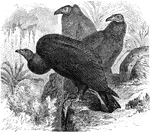
Turkey Buzzard
"Cathartes aura. Turkey Buzzard. Blackih-brown, grayer on the wing-coverts; quills black, ashy-gray…
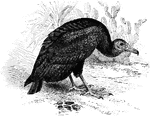
Black Vulture
"Catharista atrata. Black Vulture. Carrion Crow. Adult: Entire plumage, including skin of head, and…

Passenger Pigeon
"Ectopistes migratorius. Passenger Pigeon. Wild Pigeon Adult: Upper parts, including head all around,…
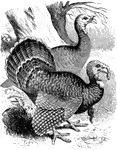
Turkey
"Meleagris gallipavo. Turkey. Upper tail-coverts chestnut, with paler or whitish tips; tail-feathers…

Canada Grouse
"Canace canadensis. Canada Grouse. Spotted Grouse. Spruce Grouse. Spruce "Partridge." Adult: Head smooth,…
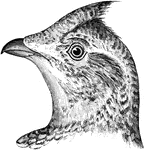
Sharp-tailed Grouse
"Pediaecetes phasianellus Columbianus. Common Sharp-tailed Grouse. Upper parts closely and pretty evenly…
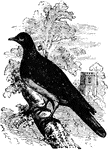
European Ring Dove
Columba palumbus. European Ring Dove. Wood Pigeon. Plumage is gray with a pinkish-purplish breast and…
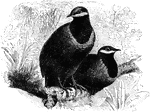
Blue-headed Quail Dove
"Starnaenas cyanocephala. Blue-headed Quail Dove. Crown rich blue bounded by black; a white stripe under…
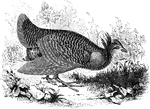
Prairie Hen
"Cupidonia cupido. Pinnated Grouse. Prairie Hen. Above, variegated with black, brown, tawny, or ochrey,…
The Foot of a Prairie Hen
"Cupidonia. Tarsi scant-feathered to the toes in front and on sides, bare on a strip behind; toes extensively…

Ruffed Grouse Head
"Bonasa umbella. Ruffed Grouse. "Partridge;" "Pheasant;" Above, variegate reddish- or grayish-brown,…
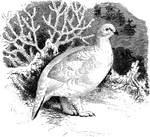
Willow Ptarmigan in Winter
"Lagopus albus. Willow Grouse. Willow Ptarmigan. Bill very stout and convex, its depth at base as the…
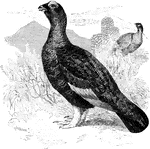
Willow Ptarmigan in Summer
"Lagopus albus. Willow Grouse. Willow Ptarmigan. Bill very stout and convex, its depth at base as the…

White-tailed Ptarmigan
"Lagopus leucurus. White-tailed Ptarmigan. Rocky Mountain Snow Grouse. Male and Female in winter: Entirely…

Quail Foot and Bill
"Ortyx. Quail. Outstretched feet reaching beyond end of tail. Bill black or blackish-brown. " Elliot…

Male and Female Bob-whites
"Ortyx virginiana. Virginia Partridge or "Quail". Bobwhite. Male: Forehead, superciliary line, and throat,…
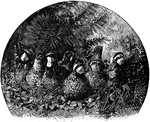
Bob-white Family
"Ortyx virginiana. Virginia Partridge or "Quail". Bobwhite. Male: Forehead, superciliary line, and throat,…
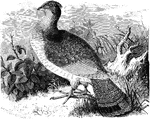
Ruffed Grouse
"Bonasa umbella. Ruffed Grouse. "Partridge;" "Pheasant;" Above, variegate reddish- or grayish-brown,…

Skull of a Chick
"Fig 64 - Skull of chick, fifth day of incubation, x 9 diameters. Seen from above, the membranous roof…
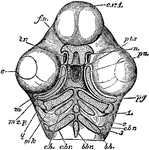
Skull of a Chick Below
"Skull of a chick, but seen from below. cv1, anterior cerebral vesicle; e, eye; m, mouth; pts, pituitary…
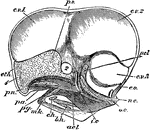
Chick Head
"Fig 66 - Head of a chick, second stage, after five days of incubation, section in profile; x6 diameters.…
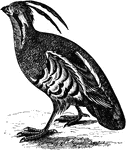
Mountain Quail
"Orortyx picta. Plumed Partridge. Mountain Quail. Back, wings and tail olive-brown, the inner secondaries…
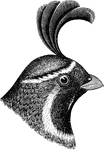
Gambel's Partridge
"Lophortyx gambeli. Gambel's Partridge. Arizona Quail. Male: Without white loral line; forehead black…
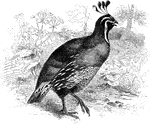
Californian Partridge
"Lophortyx californica. Californian Partridge. Valley Quail. Male: With a small white line from bill…
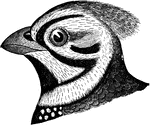
Massena Quail
"Cyrtonyx massena. Massena Partridge. Male: Upper parts intimately waved with black and reddish-brown…
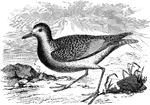
Black-bellied Plover
"Squatarola helvetica. Swiss Plover. Black-bellied Plover. Bull-head Plover. Whistling Field Plover.…
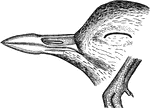
Four-toed Plover Bill and Hind Toe
"Squatarola. Four-toed Plover. A small but distinct hind toe, contrary to the rule in this family. Tail…

American Golden Plover
"Charadrius dominicus. American Golden Plover. Field Plover. Bull-head Plover. Upper parts black, everywhere…
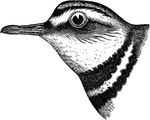
Kildeer Plover
"Aegialites vociferus. Kildeer Plover. Above, grayish-brown, with an olive shade, and in high plumage…

Oyster-catcher Bill
"Haematopus. Oyster-catcher. Bill peculiar - longer than tarsus, twice as long as head, constricted…
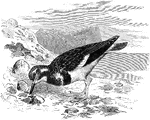
Turnstone
"Strepsilas interpres. Turnstone. Brant Bird. Calico-back. Pied above with black, white, brown, and…

Avocets Head and Foot
"Another small family, characterized by the extreme length of the slender legs, and the extreme slenderness…
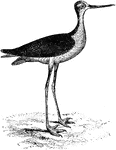
Stilt
"Himantopus. Stilts. Bill extremely slender, but not flattened, nor turned up, nor hooked; longer than…

Tomcod
The microgadus tomcod, also commonly known as tommy cod or tomcod (poulamon or petit poisson des chenaux…